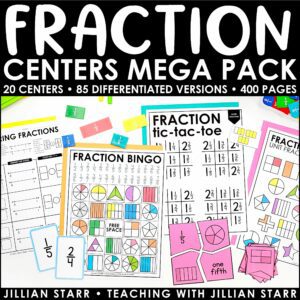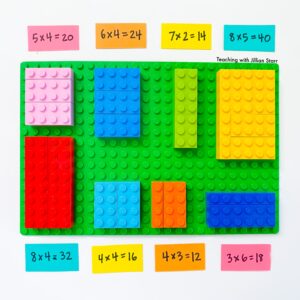
I have never met a teacher who was not given an unreasonable amount of content to teach in a given year. Our pacing guides are rarely possible, and our curriculum almost always exceeds 180 days worth of learning. This is why it’s very understandable that teachers seek out shortcuts in math to move students along with the curriculum! It seems like the perfect option…
…until we realize what the consequences those shortcuts in math have on future learning. The shortcomings that arise from these shortcuts cannot be understated, so today we’re devoting an entire article to breaking it down.
What Do We Mean by Shortcuts in Math?
We are defining a shortcut as a way to move students more quickly from one skill to the next, while (often unintentionally) bypassing conceptual development. These shortcuts in math appear to be harmless tricks, rules, or strategies in the moment. However, because students were not given the time and opportunities to deeply understand the concept, they often do not actually learn it. Instead, they have learned a trick to arrive at the correct answer.
Our goal in this post is to share a few examples of shortcuts in math (ones that I have personally taught, so know this is a judgment-free zone) and how those can become problematic. Then you will be able to take a critical look at other strategies, shortcuts, and rules that we are often encouraged to teach our students and decide if they’re really in our students’ best interest.
Examples of Shortcuts in Math
Equal means Solve
When introducing how to interpret addition and subtraction equations, teachers will often use language that unintentionally leads students to understand that the equal sign means “solve the problem.” For example, I used to read 3 + 4 = 7 as “3 plus 4 makes 7.” I was giving the equal sign an action, when in fact it is a neutral symbol that shows a comparison.
When this language continues, it reinforces this misunderstanding of the equal sign. When we correlate the equal sign with “solve the problem”, we are setting students to fail when they are introduced to problems like these:
- ___ = 2 + 4
- 3 + 8 = ___ + 5
- x + 5 = 3x – 7
Therefore we must be both careful of the language we use, and how we discuss what the equal sign symbolizes (i.e. it is a comparison symbol that shows equivalence.)
The CUBES Strategy and Relying on Keywords
The CUBES strategy and similar methods teach students to rely on keywords to solve word problems. Learning to solve word problems by looking for keywords can be misleading! When we seek words over context, we are opening the door for misunderstanding. Especially because
- There are many word problems where the keyword doesn’t indicate the expected operation
- There are many more word problems that don’t have any math keywords
Will the CUBES strategy work sometimes? Yes, definitely! My own students had some success with this strategy. Unfortunately, I was selling them short, and now know I can ask my students to use their literacy skills to approach word problems more effectively.
Instead of teaching keywords, we should be encouraging our students to think about what the addition and subtraction word problems are asking. There is no substitution for thinking!
We have two full articles about the problems with utilizing the CUBES strategy and relying on keywords in addition and subtraction word problems if you’re looking to dive deeper into this specific shortcut.
Just Add a Zero (When Multiplying by Ten)
I admit that I taught this shortcut for many years. I even included it on a free multiplication strategies poster that I shared with teachers! (You can find the updated version WITHOUT this shortcut below.)
If you’re not familiar with it, this shortcut looks like, “When you’re multiplying a number by 10, you can just add a zero to that number to get the answer. For example, in 7×10 you just take the 7 and add a zero to get 70.”
Why is this shortcut a problem? First, “add a zero” isn’t what’s actually happening when we are multiplying by ten. Instead, when students in your class naturally discover this pattern (because they will), we can talk about how the digit is shifting to the tens place and therefore there is a 0 in the ones.
How does this shortcut lead to shortcomings? Well, “add a zero” when multiplying by ten stops working when students begin multiplying decimals in fourth and fifth grade. 0.5 x 10 = 5, not .50. We don’t want students to overgeneralize a rule that only applies to whole numbers, and then have to unlearn that rule later.

Multiplication Strategy Chart
Help your students master those tricky multiplication facts with these strategies!
More About Shortcuts in Math
There are two wonderful reads that I highly recommend if you’re interested in learning more about how to avoid shortcuts in math.
The first is the article “13 Rules that Expire” from NCTM (here is a link to an abbreviated version). The full version is a fabulous read and digs into this idea across grade levels. We must see how a seemingly harmless phrase or rule can create large hurdles for students in later grades, and ultimately lead to a lot of extra work of “unlearning” for our colleagues.
The second is a quick read, “Nix the Trix” by Tina Cardone. This book is teeming with alternatives to many common shortcuts in math and explains exactly why the tricks can be harmful to understanding math.
Want to Learn EVEN MORE about Math Development?
If you found this helpful, be sure to get on the waitlist for the Meaningful Math Membership!
Meaningful Math is an online professional development community for teachers who want to build a deeper understanding of math concepts. The membership brings you:
- Our animated shorts library, which breaks down math concepts and makes them accessible to busy teachers
- Weekly podcast episodes where we do the research and give you the key takeaways to support your teaching
- Case Studies that examine common issues we see with our students
- A judgment-free community where you can ask questions, receive support, and connect with teachers just like you!
- And so much more!
Want to be the first to know when the doors reopen? Check in below!



Doors are Opening Soon!
First Grade Teachers, sign up to be the first notified when the doors to the membership open next. If you want to spend less time reteaching lessons and more time helping your students become successful mathematicians, then this is the place for you!











Leave a Comment